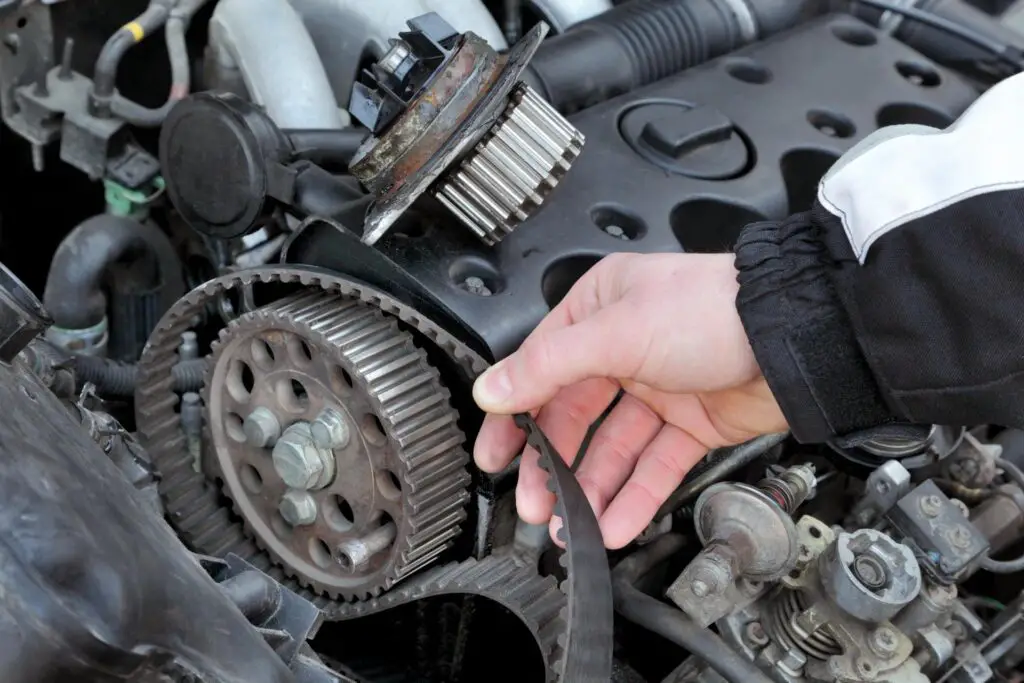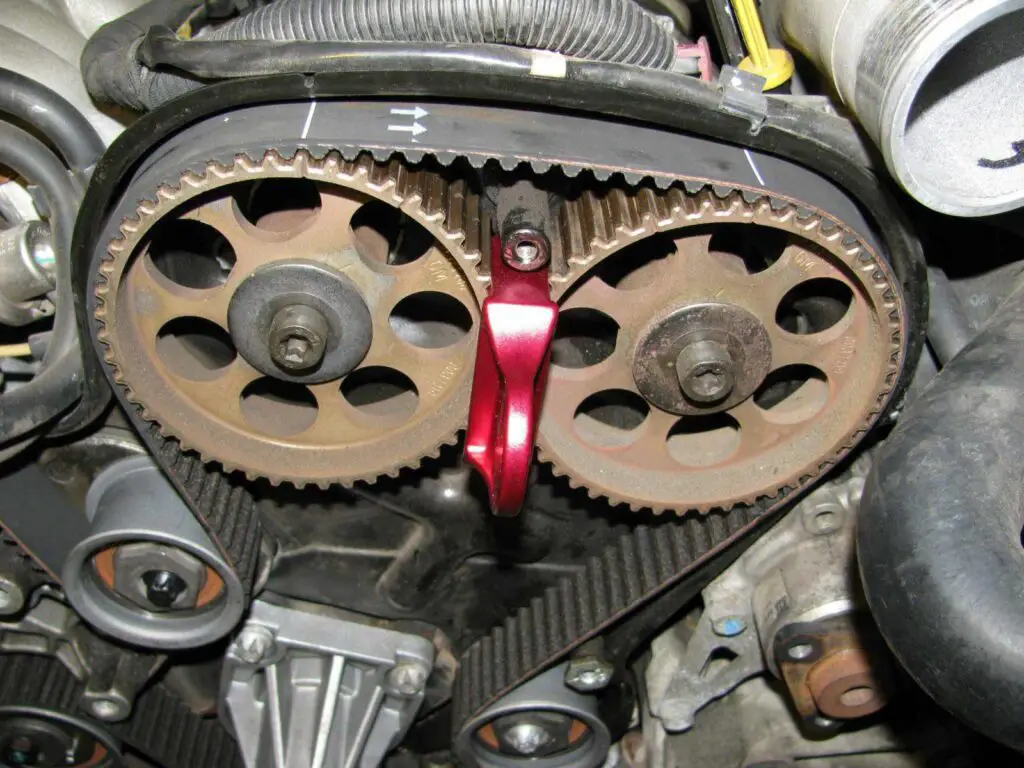A timing belt lasts 60,000 to 100,000 miles, depending on the car and conditions. Replacing it on time prevents costly engine damage.
A car’s timing belt is one of the most critical components of its engine, yet it often doesn’t get the attention it deserves-until it fails. If you’re wondering, “How long does a timing belt last?” you’re not alone. This question is vital for any vehicle owner who wants to avoid costly engine repairs and keep their car running smoothly.
In this blog post, we’ll explore how long a timing belt typically lasts, the factors that influence its lifespan, signs that it’s time to replace it, and tips to maintain it.

Contents
Typical Lifespan of a Timing Belt
Most car manufacturers recommend replacing the timing belt every 60,000 to 100,000 miles. This range can vary based on the make and model of your car and the driving conditions you frequently encounter.
Here’s a quick breakdown of how timing belt longevity might differ:
- Older Vehicles: Cars made before the mid-2000s often have shorter timing belt intervals, typically around 60,000 miles.
- Modern Vehicles: Newer models are often equipped with timing belts designed to last longer, around 90,000 to 100,000 miles, or even more in some cases.
- Heavy-Duty Usage: Vehicles frequently subjected to extreme conditions—such as towing, off-roading, or harsh weather—may require timing belt replacement sooner than the manufacturer’s guidelines suggest.
Factors That Affect Timing Belt Longevity
Several factors can influence how long a timing belt lasts:
- Driving Habits: Aggressive driving, frequent acceleration, and sudden braking can put additional stress on your timing belt, causing it to wear out faster.
- Climate: Extreme temperatures can affect the lifespan of rubber components. Excessive heat can make the belt brittle, while extreme cold can cause it to stiffen and crack.
- Maintenance Routine: Regularly servicing your vehicle according to the manufacturer’s recommendations can help detect potential timing belt issues early.
- Material Quality: The durability of your timing belt depends on its material. High-quality belts made from advanced composites or reinforced rubber will generally last longer than lower-grade alternatives.
- Oil Leaks: Oil or coolant leaks can degrade the timing belt material, significantly reducing its lifespan. If you notice any leaks near the engine, address them promptly.
Signs Your Timing Belt Needs Replacement
Replacing the timing belt before it fails is critical because a broken timing belt can lead to catastrophic engine damage. Here are some signs that it may be time to replace your timing belt:
- Squealing or Ticking Noise: A worn-out timing belt may produce unusual noises, such as a high-pitched squeal or a ticking sound coming from the engine.
- Engine Misfires: If the timing belt slips or becomes misaligned, it can cause the engine misfire or run inefficiently.
- Visible Wear and Tear: Cracks, fraying, or glazing on the timing belt are clear indicators that it’s nearing the end of its life.
- Difficulty Starting the Engine: A failing timing belt can disrupt the engine’s timing, making it hard to start your car.
- Check Engine Light: While the check engine light can signal various issues, it’s worth investigating whether the timing belt is the culprit.
Consequences of Ignoring Timing Belt Replacement
Neglecting to replace your timing belt can result in:
- Engine Damage: If the timing belt snaps, the engine’s pistons and valves can collide, causing severe damage that may require a complete engine overhaul.
- Costly Repairs: Replacing a broken timing belt is far more expensive than a routine replacement. Additionally, it can lead to damage to other engine components, such as the water pump or tensioner.
- Vehicle Breakdown: A sudden timing belt failure can leave you stranded, which is inconvenient and potentially dangerous.
Tips for Timing Belt Maintenance
- Follow Manufacturer Recommendations: Check your owner’s manual for the recommended timing belt replacement interval and adhere to it.
- Inspect Regularly: During routine maintenance, ask your mechanic to inspect the timing belt for signs of wear.
- Replace Related Components: When replacing the timing belt, consider replacing other components such as the water pump, tensioner, and idler pulleys, as they often wear out simultaneously.
- Address Leaks Promptly: Prevent oil or coolant from coming into contact with the timing belt by fixing leaks as soon as they’re detected.
- Drive Smoothly: Avoid harsh acceleration and braking to minimize stress on the timing belt.

Cost of Timing Belt Replacement
The cost of replacing a timing belt typically ranges from $300 to $1,000, depending on your car’s make, model, and labor costs in your area. While it may seem expensive, it’s a fraction of the cost of repairing engine damage caused by a snapped belt.
Frequently Asked Questions
Here are some FAQs about how long does a timing belt last –
1. What happens if my timing belt breaks while driving? If your timing belt breaks while driving, your engine will stop running immediately. In an interference engine, this can result in severe damage to the pistons and valves, leading to costly repairs.
2. Can I visually inspect my timing belt? In most cases, the timing belt is located behind a protective cover, making it difficult to inspect without removing parts of the engine. It’s best to have a professional mechanic check it during regular maintenance.
3. Is there a difference between a timing belt and a timing chain? Yes, a timing belt is made of rubber, while a timing chain is made of metal. Timing chains are generally more durable and can last the life of the engine, but they require proper lubrication.
4. How do I know if my car has a timing belt or a timing chain? You can find this information in your owner’s manual or by checking with your manufacturer or mechanic.
5. Should I replace the water pump with the timing belt? Yes, it’s a good idea to replace the water pump during timing belt replacement because both components are often located in the same area, and the labor cost overlaps.
Conclusion
The timing belt is a vital part of your car’s engine, and its proper maintenance should never be overlooked. By knowing how long a timing belt lasts, recognizing the signs of wear, and following a regular maintenance schedule, you can ensure your vehicle remains reliable and efficient. Always consult your owner’s manual and work with a trusted mechanic to keep your car in top shape.